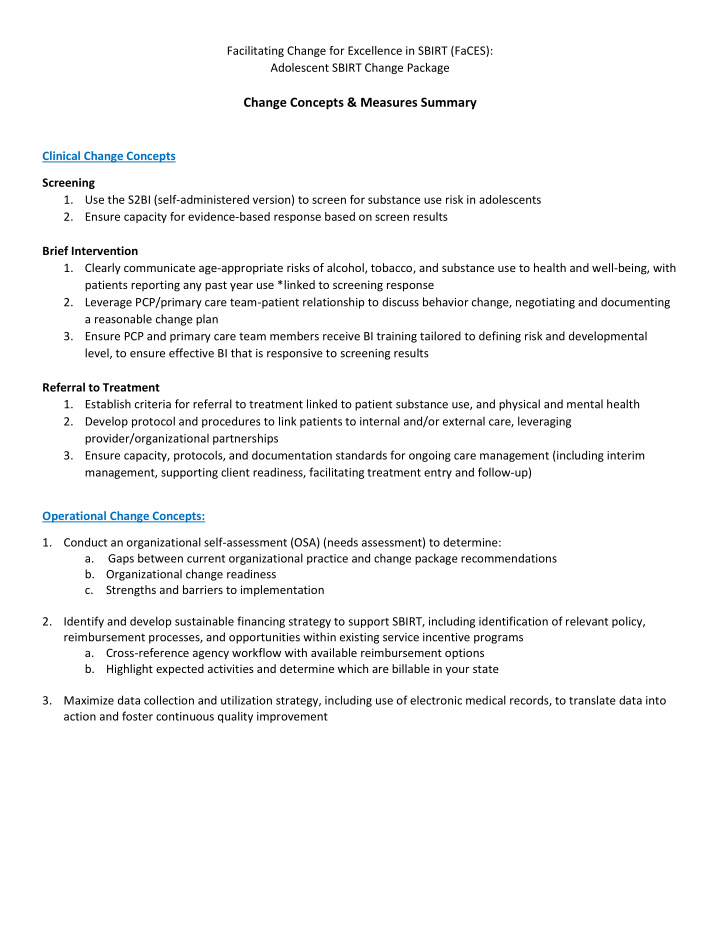



Facilitating Change for Excellence in SBIRT (FaCES): Adolescent SBIRT Change Package Change Concepts & Measures Summary Clinical Change Concepts Screening 1. Use the S2BI (self-administered version) to screen for substance use risk in adolescents 2. Ensure capacity for evidence-based response based on screen results Brief Intervention 1. Clearly communicate age-appropriate risks of alcohol, tobacco, and substance use to health and well-being, with patients reporting any past year use *linked to screening response 2. Leverage PCP/primary care team-patient relationship to discuss behavior change, negotiating and documenting a reasonable change plan 3. Ensure PCP and primary care team members receive BI training tailored to defining risk and developmental level, to ensure effective BI that is responsive to screening results Referral to Treatment 1. Establish criteria for referral to treatment linked to patient substance use, and physical and mental health 2. Develop protocol and procedures to link patients to internal and/or external care, leveraging provider/organizational partnerships 3. Ensure capacity, protocols, and documentation standards for ongoing care management (including interim management, supporting client readiness, facilitating treatment entry and follow-up) Operational Change Concepts: 1. Conduct an organizational self-assessment (OSA) (needs assessment) to determine: a. Gaps between current organizational practice and change package recommendations b. Organizational change readiness c. Strengths and barriers to implementation 2. Identify and develop sustainable financing strategy to support SBIRT, including identification of relevant policy, reimbursement processes, and opportunities within existing service incentive programs a. Cross-reference agency workflow with available reimbursement options b. Highlight expected activities and determine which are billable in your state 3. Maximize data collection and utilization strategy, including use of electronic medical records, to translate data into action and foster continuous quality improvement
Clinical Outcome Measures: Screening: Objective : Universal screening with every health maintenance visit (and potentially other visits) Documentation : Screening Results documented in chart Measure : Proportion of charts with screening documented Benchmark: 90% of adolescent presenting for well care screened with s2bi within a year (still strongly recommended opportunistic screening using clinical discretion) EHR Fields: Field for well visit, and other visits End Goal: All adolescents receive screening via the S2BI at least once a year, and are appropriately categorized for intervention Brief Intervention: Objective : Assess severity and determinants of SU and negotiate behavior change plan Documentation : Document change plan in medical record Document plan for follow up in record Document contingency plan Example: “patient is not interested in changing alcohol or marijuana use at this time, and is also not interested in a referral to treatment. I have asked patient to consider signs or problems that indicate change is necessary and return in 3 months to review/discuss” Measures : Proportion of patients who were eligible for BI for whom change plan is documented in chart Proportion of patients who return for a follow up visit within 3 months Benchmark: 80% documentation of change plan and follow up plan, or contingency plan EHR Fields: Narrative field to document plan (change/follow-up/contingency) End Goal: Patients are receiving the appropriate level of BI based on screening result Referral to Treatment: Objective : Agree with patient on need for and acceptable level of service. Ask patient for permission to include parents or caregivers Documentation : Patient agreement (“Patient has agreed to outpatient counseling at (RESOURCE; Patient HAS or HAS NOT agreed to share information with p arents; Patient HAS or HAS NOT agreed to 3 month follow up; OR “I have recommended IOP, patient is not interested in any further services at this time; … Parents…, …follow up ….) Measures : Proportion of charts eligible for referral for whom referral plan is documented in medical record Proportion of referred patients who attend initial referral visit within 60 days Proportion of patients for whom a follow up and contingency plan is documented Benchmark: Proportion of charts eligible for referral for whom referral plan is documented in medical record – 80% Proportion of referred patients who attend initial referral visit within 60 days – 50% Proportion of patients for whom a follow up and contingency plan is documented – 100% EHR Fields: Checkbox to denote if eligible for referral Narrative field to designate referral plan/follow up/contingency plans Date field to document scheduled referral visit End Goal: Based on established criteria pts receive the necessary level of care management to link to and monitor care
Operational Outcome Measures: OSA Objective: Identify organizational capacity for SBIRT implementation Documentation: OSA responses Measures: OSA Score Object Form/EHR Field: N/A Benchmark: Ability to fill identified gaps (May be more narrative than a score) Finance Objective: Develop sustainable financing strategy based on internal capacity and relevant reimbursement processes Documentation: SBIRT Financing Protocol for each component Potential Billing Codes: o Codes that allow you to add on to PC visit (BI) o Codes that allow you to bring client back for F/U Measures: The number of times identified codes are utilized Benchmark: 80% reimbursement of SBIRT activities and associated staff time Object Form/EHR Field: N/A End Goal: Financing strategy ensures SBIRT activities are reimbursed Data Collection Objective: Design a data collection process that fosters CQI: Selection, analysis and utilization of SBIRT data to enhance service delivery Documentation: Data Collection protocol Measures: Consistent assessment and utilization of SBIRT data in meetings to enhance service delivery Data consistently submitted in accordance with identified deadlines Benchmark: 100% completion of OSA Object Form/EHR Field: N/A End Goal: Data collection protocol that informs service delivery
Recommend
More recommend